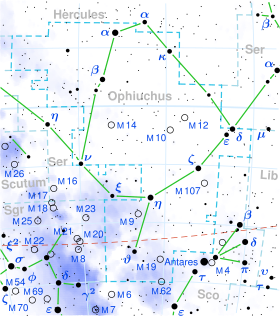70 Ophiuchi
Location of 70 Ophiuchi in the constellation Ophiuchus | ||
| Observation data Epoch J2000 Equinox | ||
|---|---|---|
| Constellation | Ophiuchus | |
| 70 Ophiuchi | ||
| Right ascension | 18h 05m 27.285s[1] | |
| Declination | +02° 29′ 00.36″[1] | |
| Apparent magnitude (V) | 4.00 - 4.03[2] | |
| A | ||
| Right ascension | 18h 05m 27.248s[3] | |
| Declination | +02° 30′ 00.53″[3] | |
| Apparent magnitude (V) | 4.13[4] | |
| B | ||
| Right ascension | 18h 05m 27.463s[5] | |
| Declination | +02° 29′ 56.21″[5] | |
| Apparent magnitude (V) | 6.07[4] | |
| Characteristics | ||
| Spectral type | K0V + K4V[6] | |
| Apparent magnitude (B) | 4.97/7.26[4] | |
| Apparent magnitude (R) | 3.6/5.6[4] | |
| U−B color index | +0.69[7] | |
| B−V color index | +0.82/+1.15[8] | |
| Variable type | BY Dra[9] or RS CVn[2] | |
| Absolute magnitude (MV) | +7.427[8] | |
Semi-amplitude (K1)(primary) | 3.51±0.04 km/s | |
| Semi-amplitude (K2) (secondary) | 4.25±0.05 km/s | |
| Details | ||
| 70 Oph A | ||
Gyr | ||
LHS 459 | ||
| Database references | ||
Exoplanet Archive | data | |
| ARICNS | data | |
70 Ophiuchi (p Ophiuchi)[15] is a binary star system located 16.7 light-years away from the Earth. It is in the constellation Ophiuchus. At magnitude 4 it appears as a dim star visible to the unaided eye away from city lights.
History
In Ptolemy's 2nd-century Almagest star catalogue this star system is listed as a 4th magnitude star, the 28th (or 4th outside the constellation figure) in Ophiuchus. It is star No. 261 in this catalogue.[16]
This star system was first catalogued as a binary star by William Herschel in the late 18th century in his study of binary stars. Herschel proved that this system is a gravitationally bound binary system where the two stars orbit around a common center of mass. This was an important contribution to the proof that Newton's law of universal gravitation applied to objects beyond the Solar System.
This star was once considered part of the obsolete constellation Taurus Poniatovii, but after the International Astronomical Union officially recognized constellations, it was placed in Ophiuchus.[17]
Variability

70 Ophiuchi is a variable star with a magnitude range for the two stars combined of 4.00 to 4.03.[2] The type of variability is uncertain and it is not clear which of the two components causes the variations. It has been suspected of being either a BY Draconis variable[9] or an RS Canum Venaticorum variable, and a period of 1.92396 days has been measured.[2]
Binary star
The primary star is a yellow-orange
Claims of a planetary system
In 1855,
T. J. J. See made a stronger claim for the existence of a dark companion in this system in 1899,[23] but Forest Ray Moulton soon published a paper proving that a three-body system with the specified orbital parameters would be highly unstable.[24] The claims by Jacob and See have both been shown to be erroneous.[25]
Discovery of a "third dark companion" was announced by Louis Berman in 1932. This "dark body" around 70 Oph A was thought to have an 18-year period and a mass of 0.1 to 0.2 the Sun's mass.[26] A claim of a planetary system was again made, this time by Dirk Reuyl and Erik Holberg in 1943. The companion was estimated to have a mass 0.008 to 0.012 that of the Sun and a 17-year period.[27] This caused quite a sensation at the time but later observations have gradually discredited this claim.[25][28][29]
The negative results of past studies does not completely rule out the possibility of planets. In 2006 a
See also
- 61 Cygni
- Barnard's Star
- List of nearest stars and brown dwarfs
References
- ^ S2CID 18759600.
- ^ AAVSO. Retrieved 2018-10-07.
- ^ S2CID 244398875. Gaia DR3 record for this source at VizieR.
- ^ .
- ^ S2CID 244398875. Gaia DR3 record for this source at VizieR.
- ^ doi:10.1086/110413.
- Bibcode:2002yCat.2237....0D.
- ^ .
- ^ . Retrieved 2018-03-08.
- .
- ^ ISSN 0004-6361.
- ^ ISSN 0004-637X.
- Bibcode:1992A&A...259..543M.
- S2CID 119209183.
- .
- ^ "Star Catalogue of Ptolemaios". Vizier.cfa.harvard.edu. 2016-01-16. Retrieved 2022-03-27.
- ^ Ian Ridpath. "Taurus Poniatovii". Star Tales. Retrieved 2023-11-01.
- ^ "/ftp/cats/more/HIP/cdroms/cats". Centre de Données astronomiques de Strasbourg. Strasbourg astronomical Data Center. Retrieved 15 October 2022.
- ^ Solstation article giving details of orbital mechanics of the system
- .
- .
- ^ "The First Exoplanet Claim: Captain William S Jacob". YouTube. 2 December 2016.
- doi:10.1086/102368.
- S2CID 117727302.
- ^ Bibcode:1988JRASC..82..140H.
- .
- doi:10.1086/144489.
- doi:10.1086/125679.
- doi:10.1086/153202.
- S2CID 16755455.
External links
- "70 Ophiuchi". SolStation. Retrieved October 24, 2005.

